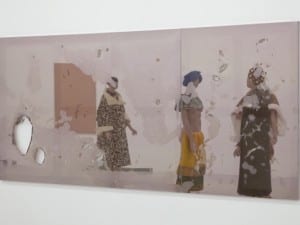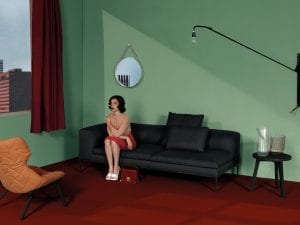Paesaggio is the fourth Massimo Bartolini (1962, Cecina, Tuscany. He lives and works in Cecina) solo show at Massimo De Carlo, in Milan. Within the radical spaces of the gallery, the horizon is conceived as a perceptual phenomenon whose presence only exists through the gaze. It occurs in an intangible space, in an ever-changing, unattainable limit. For this reason, this dynamic space becomes a symbol of consciousness; a metaphor for the threshold of the visible, the comprehensible, and of possibility.
The aim of the exhibition means to expand the notion of a material landscape. Its contemplation is the axis linking several works including, for the very first time, in Bartolini’s practice, acrylic paintings. His tenuous landscapes on the walls induce in a viewer a meditative state that is still highly experiential. Making us reflect on the relativity of what is stable and unchangeable, his works interrupt the imponderable sense of time. The subjects of these new paintings are mountain landscapes that originate from the outline of a series of monuments, mostly located in Philadelphia. These acrylic paintings where statues become mountains, as if they were human figures that have lost their posture. Only their titles, like Rocky, The Shade, Wayne, could represent as a clue to trace back their origins.
Through various media, Paesaggio offers an experience in the space that addresses a broader view of the landscape. By changing the framework through which urban, wild, archaeological, non-domestic and conceptual territories are considered, the experience of place and time also shift. Perceptions of the environment, the intimate space and present-continuous expand.
The investigations and works presented by Paesaggio explore, as a sort of a flattened echo, the heritage of landscape in the 21st century. Despite many differences among them, the works share a plastic and conceptual sensibility that alternates between abstract euphemism, the reconstructed image and a mimetic, transforming panorama. The idea of metamorphosis is an intruded on every work in the show.
For example, the papier mâché Cloud’s Club –a great lying-down bait created by the artisans that make the floats for Viareggio’s famous Italian carnival- reflects on the instability of monoculture systems and the consequences of their implementation, firmly driven by a globalized economy of the postcolonial era in which we live.
The allegorical object is inspired by a 17st century garden statue of Hercules and it tries to capture the notion of space and time from a new archaeological perspective. The artist uses light-building materials to create a minimalist and ethereal cloud, apparently held by its own coils up.In front of Cloud’s Club is set an obscure and dishevelled bronze sculpture, that has the shape of a mountain or of a corpse, entitled Giacometti Landscape, being the result of Bartolini’s shot-down monument process inspired by Femme de Venise 1 by Alberto Giacometti.
In this way, he proposes a metaphorical paradox that binds the future with the past and creates the mystery of whether what we see is a fossil concretion found in a building under construction or a fragment of a collapsed structure. The works in Paesaggio oscillate between the found, the constructed, the factual, the invented, the material and immaterial. Embracing two simultaneous existences: the object and image. A continuous research of a shimmering landscape image invites us to admire a supposedly Romantic landscape, through Rugiade, revealing Bartolini’s interest in the essence of the materials that compose the current environment, as well as a reflection on the impact on nature caused by cultural production that human demand creates.
Just as the horizon has a continuous presence and is positioned at a variably far distance, looking to the future and the past will always be just that, a projection, a reflection of memories at an apparently infinite distance. The interpretations of the contemporary landscape by Bartolini, and his constant manipulations of it, open a new space to contemplate the role of our own ritual landscapes always being situated between the line that separates earth from sky, within from without, the individual from the collective, and discard from desire. Therefore, without our gaze always toward the horizon, the exhibition invites us to gather our bearings and see where we have come from, how far we’ve gone, and where we are headed.
Ginevra Bria
Massimo Bartolini ran from 9 April until 7 May at Massimo De Carlo.
Credits:
1. Installation views Paesaggi, Massimo Bartolini Massimo De Carlo, Milano/Ventura 2016 Photo Credit: Roberto Marossi Courtesy of Massimo De Carlo, Milan/London/Hong Kong




